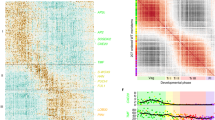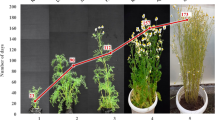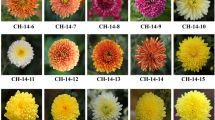Abstract
The evolutionary breakdown of tristyly to predominant self-fertilization in Eichhornia paniculata (Pontederiaceae) is associated with the spread and fixation of floral variants of the mid-styled morph (M) with modified short-level stamens. Reduced stigma–anther separation in the variants results in a high degree of self-fertilization. To investigate if the genetic basis of mating-system modification differs among floral variants from different parts of the geographical range of the species we performed controlled crosses on genotypes from six populations from N.E. Brazil and Jamaica. Measurements of floral traits in self and F1 crosses grown under uniform glasshouse conditions demonstrated that the gene(s) modifying stamen position in the M morph are largely recessive, have no apparent phenotypic effects on other floral characters and are only expressed in the M morph. Crosses between modified genotypes from northern and southern parts of N.E. Brazil resulted in F1 progeny with unmodified flowers, indicating that different recessive genes are responsible for stamen modification in the two regions. Crosses between modified genotypes from Jamaica and the two regions of N.E. Brazil indicated a more complex basis for stamen modification in Jamaica, and confirmed that the genetic basis of selfing differed between the two regions of Brazil. Our results provide evidence that the evolution of self-fertilization in E. paniculata has occurred by different genetic pathways. In addition, the data suggest that the sequence of events commences with the fixation of recessive alleles affecting only filament length, followed by evolution at modifier loci responsible for larger phenotypic changes to floral architecture.
Similar content being viewed by others
Article PDF
References
Baker, H G. 1955. Self-compatibility and establishment after ‘long-distance’ dispersal. Evolution, 11, 449–460.
Baker, H G. 1959. The contribution of autecological and genecological studies to our knowledge of the past migrations of plants. Am Nat, 93, 255–272.
Baker, H G. 1966. The evolution, functioning and breakdown of heteromorphic incompatibility systems. I. The Plumbaginaceae. Evolution, 20, 349–368.
Barrett, S C H. 1979. The evolutionary breakdown of tristyly in Eichhornia crassipes (Mart.) Solms. (Water Hyacinth). Evolution, 33, 499–510.
Barrett, S C H. 1985. Floral trimorphism and monomorphism in continental and island populations of Eichhornia paniculata (Spreng.) Solms. (Pontederiaceae). Biol J Linn Soc, 25, 41–60.
Barrett, S C H. 1988. Evolution of breeding systems in Eichhornia: a review. Ann M Bot Gard, 75, 741–760.
Barrett, S C H. 1989. Mating system evolution and speciation in heterostylous plants. In: Otte, D. and Endler, J. (eds.) Speciation and its Consequences, pp. 257–283. Sinauer Associates, Sunderland, MA.
Barrett, S C H. 1992. Heterostylous genetic polymorphisms: Model systems for evolutionary analysis. In: Barrett, S. C. H. (ed.) Evolution and Function of Heterostyly. pp. 1–29. Springer-Verlag, Berlin.
Barrett, S C H, and Charlesworth, D. 1991. Effects of a change in the level of inbreeding on the genetic load. Nature, 352, 522–524.
Barrett, S C H, and Harder, L D. 1992. Floral variation in Eichhornia paniculata (Spreng.) Solms. (Pontederiaceae). 2. Effects of development and environment on the formation of selfing flowers. J Evol Biol, 5, 83–107.
Barrett, S C H, and Husband, B C. 1990. Genetics of plant migration and colonization. In: Brown, A. H. D., Clegg, M. T, Khler, A. L. and Weir, B. S. (eds) Plant Population Genetics, Breeding and Genetic Resources, pp. 254–277. Sinauer Associates, Sunderland, MA.
Barrett, S C H, and Shore, J. 1987. Variation and evolution of breeding systems in the Turnera ulmifolia complex (Turneraceae). Evolution, 41, 340–354.
Barrett, S C H, Morgan, M T, and Husband, B C. 1989. The dissolution of a complex genetic polymorphism: The evolution of self-fertilization in tristylous Eichhornia paniculata (Pontederiaceae). Evolution, 43, 1398–1416.
Breese, E L. 1959. Selection for differing degrees of outbreeding in Nicotiana rustica. Ann Bot, 23, 331–344.
Brown, B A, and Clegg, M T. 1984. Influence of flower color polymorphism on genetic transmission in a natural population of the common morning glory, Ipomoea purpurea. Evolution, 38, 796–803.
Campbell, D R. 1989. Measurements of selection in a hermaphroditic plant: Variation in male and female pollination success. Evolution, 43, 318–334.
Campbell, R B. 1986. The interdependence of mating structure and inbreeding depression. J Theor Biol, 30, 232–244.
Charlesworth, B. 1992. Evolutionary rates in partially self-fertilizing species. Am Nat, 140, 126–148.
Charlesworth, D. 1979. The evolution and breakdown of tristyly. Evolution, 33, 486–498.
Charlesworth, D, and Charlesworth, B. 1979. A model for the evolution of distyly. Am Nat, 114, 467–498.
Charlesworth, D, and Charlesworth, B. 1990. Inbreeding depression with heterozygote advantage and its effect on selection for modifiers changing the outcrossing rate. Evolution, 44, 870–888.
Clarke, C A, and Sheppard, P M. 1960. Supergenes and mimicry. Heredity, 14, 175–185.
Clarke, C A, Sheppard, P M, and Thornton, I W B. 1968. The genetics of the mimetic butterfly Papilio memnon L. Phil Trans R Soc Ser B, 254, 5–89.
Clegg, M T, and Epperson, B K. 1988. Natural selection of flower color polymorphisms in morning glory populations. In: Gottlieb, L. D. and Jain, S. K. (eds) Plant Evolutionary Biology, pp. 255–273. Chapman and Hall, London.
Cohan, F M. 1984. Can uniform selection retard random genetic divergence between isolated conspecific populations? Evolution, 38, 495–504.
Coyne, J A, and Lande, R. 1985. The genetic basis of species differences in plants. Am Nat, 126, 141–145.
Dowrick, V P J. 1956. Heterostyly and homostyly in Primula obconica. Heredity, 10, 219–236.
Ennos, R A. 1981. Quantitative studies of the mating system in two sympatric species of Ipomoea (Convolvulaceae). Genetica, 57, 93–98.
Ernst, A. 1955. Self-fertility in monomorphic Primulas. Genetica, 27, 91–148.
Fenster, C B, and Ritland, K. 1994. The quantitative genetics of mating system divergence in the yellow monkeyflower species complex. Heredity, (in press).
Fisher, R A. 1941. Average excess and average effect of a gene substitution. Ann Eugen, 11, 53–63.
Glover, D E, and Barrett, S C H. 1986. Variation in the mating system of Eichhornia paniculata (Spreng.) Solms. (Pontederiaceae). Evolution, 40, 1122–1131.
Gottlieb, L D. 1984. Genetics and morphological evolution in plants. Am Nat, 123, 681–709.
Haldane, J B S. 1924. A mathematical theory of natural and artificial selection. Part I. Trans Camb Phil Soc, 23, 19–41.
Haldane, J B S. 1927. A mathematical theory of natural and artificial selection. Part V. Selection and mutation. Proc Camb Phil Soc, 23, 838–844.
Harder, L D, and Barrett, S C H. 1993. Pollen removal from tristylous Pontederia cordata: Effects of anther position and pollinator specialization. Ecology, 74, 1059–1072.
Harland, S C. 1936. The genetical conception of the species. Biol Rev, 11, 83–112.
Holsinger, K E. 1992. Ecological models of plant mating systems and the evolutionary stability of mixed mating systems. In: Wyatt, R. (ed.) Ecology and Evolution of Plant Reproduction, pp. 169–191. Chapman and Hall, New York.
Holsinger, K E, Feldman, M W, and Christiansen, R B. 1984. The evolution of self-fertilization in plants. A population genetic model. Am Nat, 124, 446–453.
Holtsford, T P, and Ellstrand, N C. 1992. Genetic and environmental variation in floral traits affecting outcrossing rate in Clarkia tembloriensis (Onagraceae). Evolution, 46, 216–225.
Husband, B C, and Barrett, S C H. 1992. Effective population size and genetic drift in tristylous Eichhornia paniculata (Pontederiaceae). Evolution, 46, 1875–1890.
Husband, B C, and Barrett, S C H. 1993. Multiple origins of self-fertilization in tristylous Eichhornia paniculata (Pontederiaceae): inferences from style morph and isozyme variation. J Evol Biol, 6, 591–608.
Jain, K B L, Schaller, C W, and Jain, S K. 1979. Genetic variation in the outcrossing rates in barley. Genetica, 50, 41–49.
King, J C. 1955. Evidence for the integration of the gene pool from studies of DDT resistance in Drosophila. Cold Spring Harbor Symp Quant Biol, 20, 311–317.
Kohn, J R, and Barrett, S C H. 1994. Pollen discounting and the spread of a selfing variant in tristylous Eichhornia paniculata: Evidence from experimental populations. Evolution, (in press).
Lande, R, and Schemske, D W. 1985. The evolution of self-fertilization and inbreeding depression in plants. I. Genetic models. Evolution, 39, 24–40.
Latta, R, and Ritland, K. 1993. Models for the evolution of selfing under alternative modes of inheritance. Heredity, 71, 1–10.
Lewis, D, and Jones, D A. 1992. The genetics of heterostyly. In: Barrett, S. C. H. (ed.) Evolution and Function of Heterostyly, pp. 129–150. Springer-Verlag, Berlin.
Macnair, M R, and Cumbes, Q J. 1989. The genetic architecture of interspecific variation in Mimulus. Genetics, 122, 211–222.
Marshall, D F, and Abbott, R J. 1982. Polymorphism for outcrossing frequency at the ray floret locus in Senecio vulgaris L. I. Evidence. Heredity, 48, 227–235.
Mather, K. 1950. Genetic architecture of heterostyly in Primula sinensis. Evolution, 4, 340–352.
McKenzie, J A, Whitten, M J, and Adena, M A. 1982. The effect of genetic background on the fitness of diazinon resistance genotypes of the Australian sheep blowfly, Lucilia cuprina. Heredity, 49, 1–9.
Moore, D M, and Lewis, H. 1965. The evolution of self-pollination in Clarkia xantiana. Evolution, 19, 104–114.
Orr, A H, and Coyne, J A. 1992. The genetics of adaptations: A reassessment. Am Nat, 140, 725–742.
Richards, J H, and Barrett, S C H. 1987. Development of tristyly in Pontederia cordata L. 1. Mature floral structure and patterns of relative growth of reproductive organs. Am J Bot, 74, 1831–1841.
Richards, J H, and Barrett, S C H. 1992. The development of heterostyly. In: Barrett, S. C. H. (ed.) Evolution and Function of Heterostyly, pp. 85–127. Springer-Verlag, Berlin.
Rick, C M. 1947. A hair-suppressing gene that indirectly affects fruitfulness and the proportion of cross-pollination in the tomato. Genetics, 32, 101–102.
Ross, M D, and Abbott, R J. 1987. Fitness, sexual asymmetry, functional sex and selfing in Senecio vulgaris L. Evol Trends Plants, 1, 21–28.
Schoen, D J. 1982. The breeding system of Gilia achilleifolia: Variation in floral characteristics and outcrossing rate. Evolution, 36, 352–360.
Seburn, C N, Dickinson, T A, and Barrett, S C H. 1990. Floral variation in Eichhornia paniculata (Spreng.) Solms. (Pontederiaceae). 1. Instability of stamen position in genotypes from N.E. Brazil. J Evol Biol, 3, 103–123.
Shore, J S, and Barrett, S C H. 1985. Genetics of distyly and homostyly in the Turnera ulmifolia complex (Turneraceae). Heredity, 55, 167–174.
Shore, J S, and Barrett, S C H. 1990. Quantitative genetics of floral characters in homostylous Turnera ulmifolia var. angustifolia (Turneraceae). Heredity, 64, 105–112.
Toppings, P. 1989. The Significance of Inbreeding Depression to the Evolution of Self-fertilization in Eichhornia paniculata (Spreng.) Solms. (Pontederiaceae). M. Sc. Thesis, University of Toronto.
Turner, J R G. 1981. Adaptation and evolution in Heliconius: a defense of neo-Darwinism. Ann Rev Ecol Syst, 12, 99–121.
Vasek, F C. 1968. Outcrossing in natural populations. IV. A comparison of outcrossing estimation methods. In: Drake, E. T. (ed.) Evolution and Environment. Yale University Press, New Haven, CT.
Wilkens, H. 1971. Genetic interpretation of regressive evolutionary processes: studies on hybrid eyes of two astyanax cave populations. Evolution, 25, 530–540.
Wright, S. 1931. Evolution in Mendelian populations. Genetics, 16, 97–159.
Wright, S. 1968. Evolution and the Genetics of Populations I Genetic and Biometrical Foundations. The University of Chicago Press, Chicago.
Author information
Authors and Affiliations
Rights and permissions
About this article
Cite this article
Fenster, C., Barrett, S. Inheritance of mating-system modifier genes in Eichhornia paniculata (Pontederiaceae). Heredity 72, 433–445 (1994). https://doi.org/10.1038/hdy.1994.62
Received:
Issue date:
DOI: https://doi.org/10.1038/hdy.1994.62
Keywords
This article is cited by
-
Genomic consequences of transitions from cross- to self-fertilization on the efficacy of selection in three independently derived selfing plants
BMC Genomics (2012)
-
De novo sequence assembly and characterization of the floral transcriptome in cross- and self-fertilizing plants
BMC Genomics (2011)
-
Differences in the genetic basis of leaf dissection between two populations of Crepis tectorum (Asteraceae)
Heredity (1995)
-
Levels of genetic variation and covariation for Mimulus (Scrophulariaceae) floral traits
Heredity (1994)
-
Quantitative genetics of mating system divergence in the yellow monkeyflower species complex
Heredity (1994)



